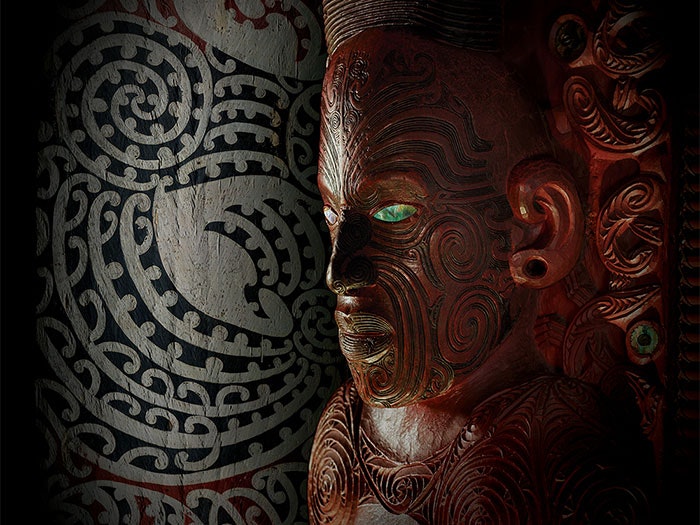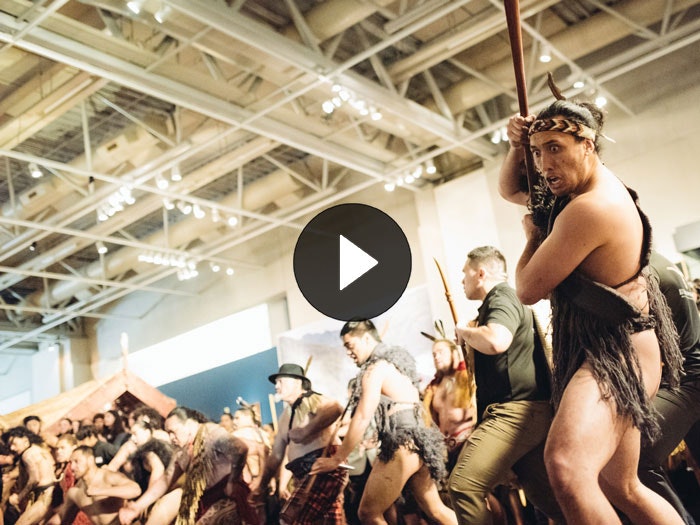Gisborne iwi Rongowhakaata’s exhibition opens at Te Papa end of September
18 September 2017
The major new exhibition Ko Rongowhakaata: The Story of Light and Shadow, which showcases the dramatic stories, histories, treasured taonga and the exceptional artistry of the Gisborne iwi, will open at Te Papa on Friday 29 September.
Rongowhakaata taonga, 2017. Photograph by Michael O’Neill. Courtesy of Toko Toru Tapu Church and Te Hau ki Tūranga Trust
Te Papa Chief Executive Geraint Martin says “It's a privilege to present this important exhibition, and to continue the legacy of the Iwi-in-Residence programme which is one of the ways in which Te Papa embodies what it means to be a bicultural museum.”
This is the eighth iwi exhibition programme since Te Papa opened in 1998.
Te Papa Kaihautū (Māori Co-leader) Dr Arapata Hakiwai says the exhibition enables iwi to tell their own stories and present their taonga in their own way.
“It’s a particularly moving experience for me, as I am of Rongowhakaata descent, to see my people’s journey presented so powerfully,” he says.
Rongowhakaata Iwi Trust Chairperson Moera Brown says this exhibition marks a significant milestone of our cultural aspirations and is also an opportunity for closer ties and whanaungatanga (relationship, kinship) with Te Papa.
“This exhibition continues Rongowhakaata’s cultural outreach initiated by a series of exhibitions at the iwi’s five marae – Manutūkē, Ōhako, Pāhou, Te Kurī, and Whakatō, in early 2016 and the award-winning iwi exhibition at Tairawhiti Museum held in December last year.
We welcome you to our exhibition – a gateway into the world of our people. It portrays our vital connection with our origins and home area of Tūranga and how these continue to frame and influence our expressions of who we are and how we engage in the world,” Ms Brown says.
The theme of light and shadow refers to the impact of light on the East Coast landscape and its influence on Rongowhakaata creative expression. This can be seen in the high relief of the iwi’s carving, for which it’s renowned.
The world’s oldest surviving whare whakairo (carved meeting house), Te Hau ki Tūranga, sits at the heart of the exhibition. Built in the 1840s and wrongfully confiscated by the Crown in 1867, Te Hau ki Tūranga was then held by the Colonial Museum, displayed at the Dominion Museum and moved to Te Papa where it has been displayed since 1998. In 2012, as part of Rongowhakaata’s Treaty of Waitangi settlement, the New Zealand government apologised for the forcible removal of Te Hau ki Tūranga, stating that the whare whakairo belongs to Rongowhakaata. Throughout the course of the two and a half year exhibition Rongowhakaata will commence restoration of their precious taonga and Te Papa supports the iwi’s aspirations for the whare. The exhibition’s opening date, September 29, is significant as it marks 144 years since the passing of Raharuhi Rukupō the master carver who conceived and helped build, alongside 18 other carvers, the 175 year old whare.
The strength and the continuity of Rongowhakaata's culture and innovative spirit will be presented in the exhibition through collection items, loans from families and institutions, commissioned artworks, digital media and the stories of the iwi.
Te Papa has commissioned senior Rongowhakaata artist, Arts Foundation Laureate and Professor (Ahorangi) Derek Lardelli to create a major work that reflects Rongowhakaata creative expression. His carved work Ngā manu a Rongo reflects the influence of Rongowhakaata’s ancestors through time.
More than 150 taonga will be displayed in the exhibition, including:
carving from some of Rongowhakaata’s most important tohunga whakairo (master carvers)
Te Kooti's prayer book from 1866, written by him during his wrongful imprisonment on the Chatham Islands
Wi Pere’s whale bone tokotoko (oratory stick) carved by Raharuhi Rukupō
intricate kōwhaiwhai panels from the Toko Toru Tapu church built in the mid 1800s
an original hoe (paddle) traded during Rongowhakaata’s 1769 encounter with James Cook
examples of outstanding weaving, including beautiful kākahu (cloaks)
the typewriter Witi Ihimaera used to write Pounamu, Pounamu.
Visitors will be immersed in an engaging audio-visual environment that will include:
projections and soundscapes, and the works of Rongowhakaata composers, such as Tama Waipara, and Rob Ruha
multi-screen AV showing footage of the iwi’s five marae and its hapū to welcome visitors
an animation of Rongowhakaata’s account of Cook’s visit in 1769 to Tūranga (Gisborne)
The exhibition Ko Rongowhakaata: The Story of Light and Shadow will have a ceremonial opening (pōwhiri) on Friday 29 September with a large contingent of iwi who will have travelled from all over New Zealand.

